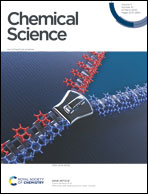A designed second-sphere hydrogen-bond interaction that critically influences the O–O bond activation for heterolytic cleavage in ferric iron–porphyrin complexes†
Abstract
Heme hydroperoxidases catalyze the oxidation of substrates by H2O2. The catalytic cycle involves the formation of a highly oxidizing species known as Compound I, resulting from the two-electron oxidation of the ferric heme in the active site of the resting enzyme. This high-valent intermediate is formed upon facile heterolysis of the O–O bond in the initial FeIII–OOH complex. Heterolysis is assisted by the histidine and arginine residues present in the heme distal cavity. This chemistry has not been successfully modeled in synthetic systems up to now. In this work, we have used a series of iron(III) porphyrin complexes (FeIIIL2(Br), FeIIIL3(Br) and FeIIIMPh(Br)) with covalently attached pendent basic groups (pyridine and primary amine) mimicking the histidine and arginine residues in the distal-pocket of natural heme enzymes. The presence of pendent basic groups, capable of 2nd sphere hydrogen bonding interactions, leads to almost 1000-fold enhancement in the rate of Compound I formation from peracids relative to analogous complexes without these residues. The short-lived Compound I intermediate formed at cryogenic temperatures could be detected using UV-vis electronic absorption spectroscopy and also trapped to be unequivocally identified by 9 GHz EPR spectroscopy at 4 K. The broad (2000 G) and axial EPR spectrum of an exchange-coupled oxoferryl-porphyrin radical species, [FeIV![[double bond, length as m-dash]](https://www.rsc.org/images/entities/char_e001.gif) O Por˙+] with geff⊥ = 3.80 and geff‖ = 1.99, was observed upon a reaction of the FeIIIL3(Br) porphyrin complex with m-CPBA. The characterization of the reactivity of the FeIII porphyrin complexes with a substrate in the presence of an oxidant like m-CPBA by UV-vis electronic absorption spectroscopy showed that they are capable of oxidizing two equivalents of inorganic and organic substrate(s) like ferrocene, 2,4,6-tritertiary butyl phenol and o-phenylenediamine. These oxidations are catalytic with a turnover number (TON) as high as 350. Density Functional Theory (DFT) calculations show that the mechanism of O–O bond activation by 2nd sphere hydrogen bonding interaction from these pendent basic groups, which are protonated by a peracid, involves polarization of the O–O σ-bond, leading to lowering of the O–O σ*-orbital allowing enhanced back bonding from the iron center. These results demonstrate how inclusion of 2nd sphere hydrogen bonding interaction can play a critical role in O–O bond heterolysis.
O Por˙+] with geff⊥ = 3.80 and geff‖ = 1.99, was observed upon a reaction of the FeIIIL3(Br) porphyrin complex with m-CPBA. The characterization of the reactivity of the FeIII porphyrin complexes with a substrate in the presence of an oxidant like m-CPBA by UV-vis electronic absorption spectroscopy showed that they are capable of oxidizing two equivalents of inorganic and organic substrate(s) like ferrocene, 2,4,6-tritertiary butyl phenol and o-phenylenediamine. These oxidations are catalytic with a turnover number (TON) as high as 350. Density Functional Theory (DFT) calculations show that the mechanism of O–O bond activation by 2nd sphere hydrogen bonding interaction from these pendent basic groups, which are protonated by a peracid, involves polarization of the O–O σ-bond, leading to lowering of the O–O σ*-orbital allowing enhanced back bonding from the iron center. These results demonstrate how inclusion of 2nd sphere hydrogen bonding interaction can play a critical role in O–O bond heterolysis.



 Please wait while we load your content...
Please wait while we load your content...